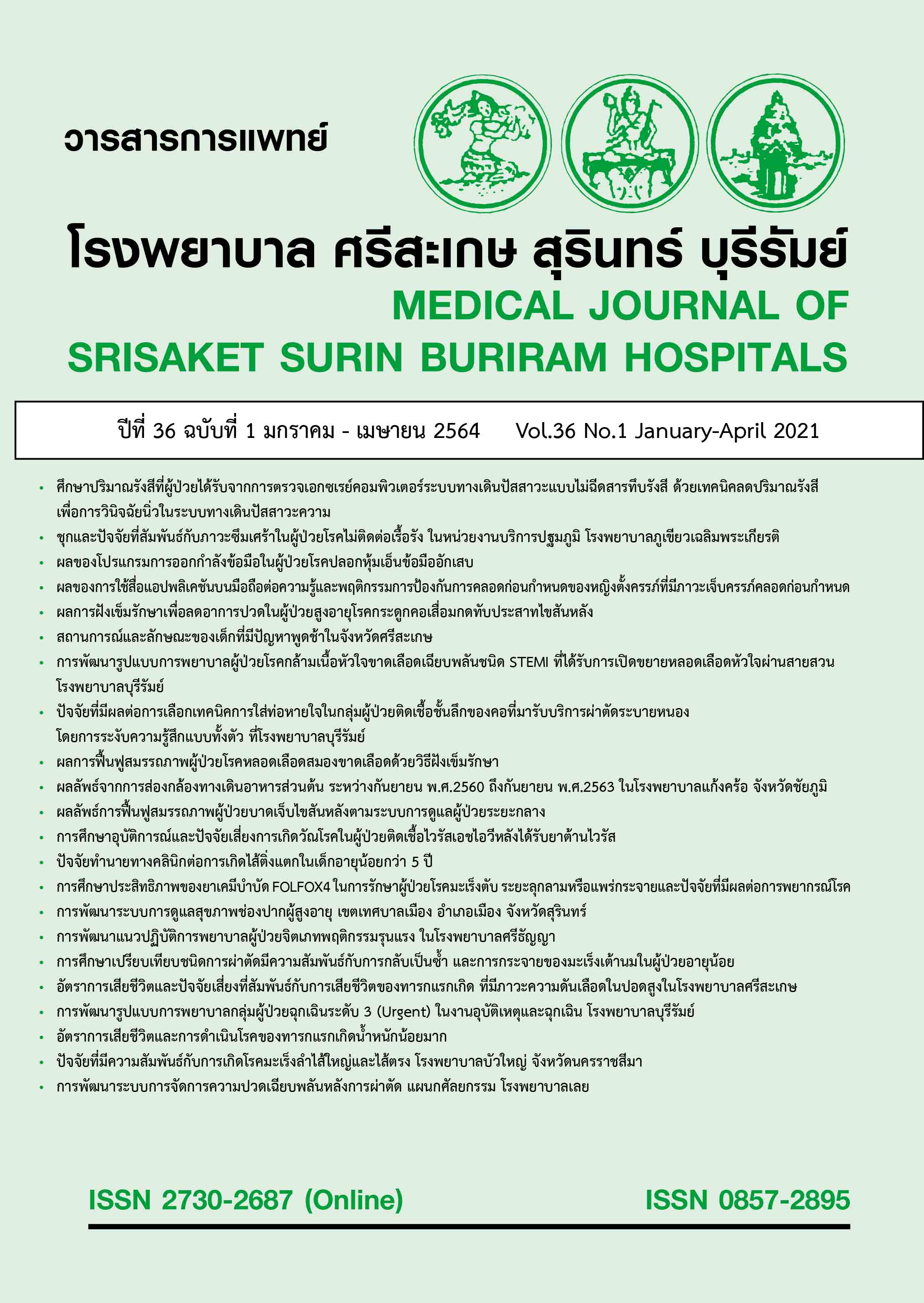ศึกษาปริมาณรังสีที่ผู้ป่วยได้รับจากการตรวจเอกซเรย์คอมพิวเตอร์ระบบทางเดินปัสสาวะแบบไม่ฉีดสารทึบรังสี ด้วยเทคนิคลดปริมาณรังสี เพื่อการวินิจฉัยนิ่วในระบบทางเดินปัสสาวะ
Main Article Content
บทคัดย่อ
หลักการและเหตุผล: นิ่วในระบบทางเดินปัสสาวะ จัดเป็นปัญหาสาธารณสุขที่สำคัญ เนื่องจากมีอัตราการเกิดโรคและอัตราการเป็นซ้ำสูงขึ้นทุกปี ปัจจุบันได้มีแนวทางปฏิบัติกำหนดให้การตรวจเอกซเรย์คอมพิวเตอร์ระบบทางเดินปัสสาวะแบบไม่ฉีดสารทึบรังสีเป็นมาตรฐานในการตรวจหานิ่วระบบทางเดินปัสสาวะ แต่วิธีนี้จะทำให้ผู้ป่วยได้รับรังสีในปริมาณที่สูงกว่าการตรวจด้วยวิธีอื่น
วัตถุประสงค์: เพื่อศึกษาการตรวจเอกซเรย์คอมพิวเตอร์ระบบทางเดินปัสสาวะโดยใช้เทคนิคลดปริมาณรังสีในการวินิจฉัยนิ่วระบบทางเดินปัสสาวะ
วิธีการ: ศึกษาเชิงทดลอง โดยเก็บข้อมูลทั่วไปและปริมาณรังสีที่ได้รับในผู้ป่วย 15 ราย ที่ตรวจโดยใช้เทคนิคลดปริมาณรังสี (30-100 mA) เปรียบเทียบกับข้อมูลย้อนหลังของผู้ป่วย 47 ราย ที่ตรวจโดยใช้ปริมาณรังสีปกติ (50-300 mA) ณ โรงพยาบาลปราสาท จังหวัดสุรินทร์
ผลการศึกษา: การตรวจด้วยเทคนิคลดปริมาณรังสีจะทำให้ผู้ป่วยได้รับปริมาณรังสีลดลงในทุกกลุ่มดัชนีมวลกาย โดยลดลงอย่างมีนัยสำคัญ (p-value<0.001) ในกลุ่มน้ำหนักสมส่วน กลุ่มน้ำหนักเกินและกลุ่มอ้วนระดับ1 โดยผู้ป่วยจะได้รับ CTDIvol, DLP และปริมาณรังสียังผลลดลงร้อยละ 41.7-54.1, 49.2-56.4 และ 49.2-56.4 ตามลำดับ สามารถให้ผลการวินิจฉัยนิ่วได้ตรงกับการตรวจด้วยปริมาณรังสีปกติมี Intra- และ Inter-rater reliability อยู่ในระดับสอดคล้องมากที่สุดขนาดของนิ่วที่เล็กที่สุดที่ตรวจพบคือ 1 มิลลิเมตร
สรุป: การตรวจเอกซเรย์คอมพิวเตอร์ระบบทางเดินปัสสาวะแบบไม่ฉีดสารทึบรังสีโดยใช้เทคนิคลดปริมาณรังสี (30-100 mA) จะทำให้ผู้ป่วยได้รับปริมาณรังสีลดลงสูงสุดประมาณร้อยละ 50 โดยภาพที่ได้ยังคงมีคุณภาพดีและสามารถให้ผลการวินิจฉัยนิ่วในทางเดินปัสสาวะได้ตรงกับการตรวจด้วย ปริมาณรังสีปกติ
คำสำคัญ: นิ่วระบบทางเดินปัสสาวะ เอกซเรย์คอมพิวเตอร์ เทคนิคลดปริมาณรังสี
Article Details
เอกสารอ้างอิง
Wells CC, Chandrashekar KB, Jyothirmayi GN. Kidney Stones: Current Diagnosis and Management. Clinician Rev 2012;22(2):31-37.
Romero V, Akpinar H, Assimos DG. Kidney stones: a global picture of prevalence, incidence, and associated risk factors Rev Urol 2010;12(2-3):e86-96. PMID: 20811557
Liu Y, Chen Y, Liao B, Luo D, Wang K, Li H, et al. Epidemiology of urolithiasis in Asia. Asian J Urol 2018;5(4):205-14. doi: 10.1016/j.ajur.2018.08.007.
Leusmann DB, Niggemann H, Roth S, von Ahlen H. Recurrence rates and severity of urinary calculi. Scand J Urol Nephrol 1995;29(3):279-83. doi: 10.3109/00365599509180576.
ปิยะรัตน์ โตสุโขวงศ์, ฉัตรชัย ยาจันทร์ทา, ทศพล ศศิวงศ์ภักดี, ชาญชัย บุญหล้า, เกรียง ตั้งสง่า. โรคนิ่วไต : พยาธิสรีระวิทยา การรักษา และการสร้างเสริมสุขภาพ. Chula Med J 2006;50(2):103-26.
Gervaise A, Gervaise-Henry C, Pernin M, Naulet P, Junca-Laplace C, Lapierre-Combes M. How to perform low-dose computed tomography for renal colic in clinical practice. Diagn Interv Imaging 2016;97(4):393-400. doi: 10.1016/j.diii.2015.05.013.
Ziemba JB, Matlaga BR. Epidemiology and economics of nephrolithiasis. Investig Clin Urol 2017;58(5):299-306. doi: 10.4111/icu.2017.58.5.299.
Rodger F, Roditi G, Aboumarzouk OM. Diagnostic Accuracy of Low and Ultra-Low Dose CT for Identification of Urinary Tract Stones: A Systematic Review Urol Int 2018;100(4):375-385. doi: 10.1159/000488062.
Sung MK, Singh S, Kalra MK. Current status of low dose multi-detector CT in the urinary tract. World J Radiol 2011;3(11):256-65. doi: 10.4329/wjr.v3.i11.256.
Albert JM. Radiation risk from CT: implications for cancer screening. AJR Am J Roentgenol. 2013 Jul;201(1):W81-7. doi: 10.2214/AJR.12.9226.
Poletti PA, Platon A, Rutschmann OT, Schmidlin FR, Iselin CE, Becker CD. Low-dose versus standard-dose CT protocol in patients with clinically suspected renal colic. AJR Am J Roentgenol 2007;188(4):927-33. doi: 10.2214/AJR.06.0793.
Faiq SM, Naz N, Zaidi FB, Rizvi A. Diagnostic accuracy of ultrasound & X-Ray KUB in Ureteric Colic taking CT as gold standard. IJEHSR 2014;2(1):22-7.
Weisenthal K, Karthik P, Shaw M, Sengupta D, Bhargavan-Chatfield M, Burleson J, et al. Evaluation of Kidney Stones with Reduced-Radiation Dose CT: Progress from 2011-2012 to 2015-2016-Not There Yet. Radiology 2018;286(2):581-9. doi: 10.1148/radiol.2017170285.
Nagel HD. 3 CT parameters that influence the radiation dose. In: Track D, Gevenois PA, editors. Radiation dose from adult and pediatric multidetector computed tomography. 1st ed. Heidelberg: Springer; 2017:51-79.
Goldman LW.Principles of CT: radiation dose and image quality. J Nucl Med Technol 2007;35(4):213-25; quiz 226-8. doi: 10.2967/jnmt.106.037846.
Wang PI, Chong ST, Kielar AZ, Kelly AM, Knoepp UD, Mazza MB, et al. Imaging of pregnant and lactating patients: part 1, evidence-based review and recommendations. AJR Am J Roentgenol 2012;198(4):778-84. doi: 10.2214/AJR.11.7405.
Bernard B. Fundamentals of Biostatistics. 5th. ed. Duxbery: Thomson learning; 2000:384-5.
Taylor EN, Stampfer MJ, Curhan GC. Obesity, weight gain, and the risk of kidney stones. JAMA 2005;293(4):455-62. doi: 10.1001/jama.293.4.455.
Chan VO, McDermott S, Buckley O, Allen S, Casey M, O'Laoide R, et al. The relationship of body mass index and abdominal fat on the radiation dose received during routine computed tomographic imaging of the abdomen and pelvis. Can Assoc Radiol J 2012;63(4):260-6. doi: 10.1016/j.carj.2011.02.006.


